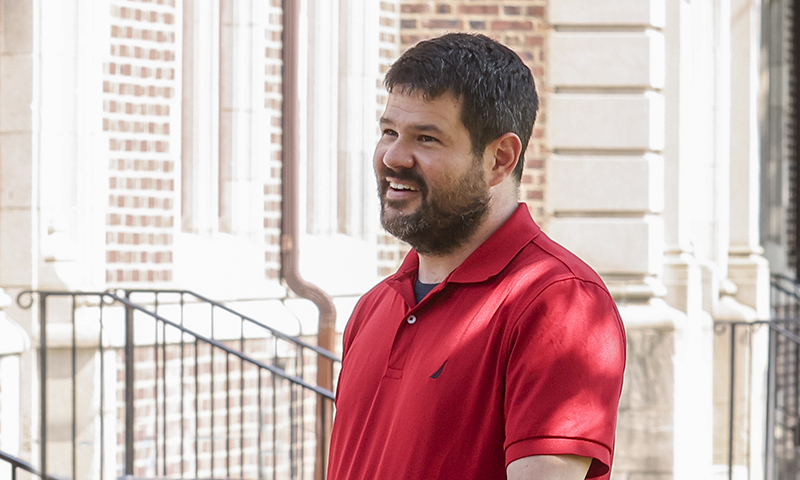
Joseph Rusinko

Joseph RusinkoAssociate Professor of Mathematics & Computer ScienceChair, Mathematics & Computer Science
Joined faculty in 2015
Ph.D., University Georgia, 2007 (Mathematics)
B.S. Davidson College, 2001 (Mathematics and German)
Download CVContact Information
Scholarly Interest
Phylogenomics:
How did life evolve on earth? How can we develop a picture of the past from the data of the present? How are we all connected? My research group in Mathematical Phylogenomics combines tools from mathematics, statistics, and computer science, to develop computational and theoretical tools to help address these questions.
Algebraic Geometry and Statistics:
Most students learn about polynomials about solving problems (Find all solutions to y=x^2+1). I am interested in polynomials as a tool for understanding geometric structure. The polynomials reveal information about the geometry of higher dimensional objects. These objects often appear in models ranging from robotics to chemical networks, and from machine learning. These geometric structures can be used as tools in ranging from machine learning to understanding how a mouse brain structures the map of its surroundings.
Using mathematics to explore new (to me) fields.
I enjoy few things more than a mathematical or computational exploration of new fields. I prefer to do this in low stake environments so that the joy of exploration is not restricted by rigid publication demands. Fun explorations include:
How does fabric fall when draped over a pin? A student collaborator took this work to a position as a Disney animator.
How does our brain understand our surroundings? A student collaborator is taking this work to a Ph.D. program in neuroscience.
Can machine learning enable me to defeat my children in Madden? No. But I've been able to apply much of what I learned in this project to other more practical areas.
Is the peace and centrality of yoga, explainable through mathematical symmetries? Perhaps, we weren't able to answer this question, but I did learn a remarkable number of new awkward ways I could almost twist my body. My student learned she could bring her identity to mathematics and is now works in computational linguistics,
Do the particular symbols we use to solve mathematics problems impact students' ability to solve them? Answer yes. This collaboration has led several students to pursue long-term careers in mathematics education.
If you are curious about how mathematics might be useful in regards to something you care about. Please reach out. I promise that I am not an expert in either the subject matter, or in the best mathematical tools to address the problem, but learning is fun.
Teaching Experience
Teaching: I have spent my career challenging the norms and expectations of the mathematical classroom. How does one shift the classroom from a place where students learn math to a place where students become mathematical thinkers?
How do we transmit the ownership of mathematical questioning from teacher to student? This means flipping the question "when am I ever going to need this?" to "can I think of a creative area to apply this to something that matters to me?"
How do we break down the structures and stereotypes which have prevented many students from belonging int the mathematical community, and limited their engagement? Naming stereotype threat; focusing on what students know rather than what they don't.; Assuming that all people can succeed as mathematicians; collective interrogation of the norms and history of the discipline; breaking down the false narrative that academic performance is the same as human value.
This is what I try to do as an educator. In the classroom, there have been many successes and probably more failures. Not all strategies I've tried have been effective, it is not always possible to break through 12 years of traditional mathematics training in a semester. Much like in scholarship, I do not know the answers to these questions, but they are certainly worth engaging.
Courses Taught
FSEM 124 Is Computing Biased? Every day people teach computers how to learn about humans. Machines learn which emails you would like to receive, which advertisements you would like to view, which medical diagnoses are appropriate, and which credit card transactions are yours. In short, humans are training computers to understand humans in ways in which we have failed to understand each other before. However, as we train computers to think about humanity we are also teaching them our weaknesses. In this seminar, we examine how humans are training computers to be biased. Typically, this is not happening intentionally but rather implicitly. Regardless of the intentions, the impact of biased artificial intelligence is real. The semester will be broken into three major questions. What is Implicit Bias? How do we train computers to learn? Can we stop teaching computers to be biased? Along the way, we will consider the implications of these questions on our learning and development.
MATH 100 Elementary Functions Intended for students who plan to continue in the calculus sequence, this course involves the study of basic functions: polynomial, rational, exponential, logarithmic, and trigonometric. Topics include a review of the real number system, equations and inequalities, graphing techniques, and applications of functions. A problem-solving lab is an integral part of the course. Permission of the instructor is required. This course does not count toward the major or minor in mathematics. (Offered annually)
MATH 130 Calculus I This course offers a standard introduction to the concepts and techniques of the differential calculus of functions of one variable. A problem-solving lab is an integral part of the course. This course does not count towards the major in mathematics. Prerequisite: Satisfactory performance on the department’s placement exam, or MATH 100. (Offered each semester)
MATH 135 First Steps Into Advanced Mathematics This course emphasizes the process of mathematical reasoning, discovery, and argument. It aims to acquaint students with the nature of mathematics as a creative endeavor, demonstrates the methods and structure of mathematical proof, and focuses on the development of problem-solving skills. Specific topics covered vary from year to year. MATH 135 is required for the major and minor in mathematics. Prerequisite: MATH 131, MATH 232 or permission of the instructor. (Offered each semester)
MATH 214 App Linear Algebra A continuation of linear algebra with an emphasis on applications. Among the important topics are eigenvalues and eigenvectors, diagonalization, and linear programming theory. The course explores how the concepts of linear algebra are applied in various areas, such as, graph theory, game theory, differential equations, Markov chains, and least squares approximation. Prerequisite: MATH 204. (Offered alternate years)
MATH 232 Multivariable Calculus A study of the concepts and techniques of the calculus of functions of several variables, this course is required for the major in mathematics. Prerequisite: MATH 131. (Offered annually)
MATH 278 Number Theory This course couples reason and imagination to consider a number of theoretical problems, some solved and some unsolved. Topics include divisibility, primes, congruences, number theoretic functions, primitive roots, quadratic residues, and quadratic reciprocity, with additional topics selected from perfect numbers, Fermat’s Theorem, sums of squares, and Fibonacci numbers. Prerequisites: MATH 131 and MATH 204, or permission of the instructor. (Offered alternate years)
MATH 375 Abstract Algebra I This course studies abstract algebraic systems such as groups, examples of which are abundant throughout mathematics. It attempts to understand the process of mathematical abstraction, the formulation of algebraic axiom systems, and the development of an abstract theory from these axiom systems. An important objective of the course is mastery of the reasoning characteristic of abstract mathematics. Prerequisites: MATH 135 and MATH 204, or permission of the instructor. (Offered annually)
MATH 471 Mathematics Capstone While the subject matter varies, the writing enriched capstone seminar addresses an advanced topic in mathematics. The development of the topic draws on students’ previous course work and helps consolidate their earlier learning. Students are active participants, presenting material to one another in both oral and written form, and conducting individual research on related questions or analyzing a specific mathematical concept from multiple perspectives. Prerequisite: MATH 331 or MATH 375, senior status or permission of the instructor. (Offered annually)
MATH 450 Independent Study
MATH 495 Honors
Publications
Selected Publications:
J. Rusinko. Phylogenetics. Chapter 20.2 in Handbook of Discrete and Combinatorial Mathematics, Second Edition. (2017).
J. Parsley and J. Rusinko. CRP: Collaborative Research Project (A Mathematical Research Experience for Undergraduates). PRIMUS. 27.4-5 (2017).
M. Mauhar*, J. Rusinko and Z. Vernon*. H-Representation of the Kimura-3 Polytope for the m-Claw Tree. SIAM Journal of Discrete Mathematics. 31.2 (2017)
R. Davidson, J. Rusinko, Z. Vernon*, and J. Xi. Modeling the distribution of distance data in Euclidean space. Book Chapter in AMS Contemporary Mathematics Series: Algebraic and Geometric Methods in Applied Discrete Mathematics 685 (2017).
K. Abernathy, Z. Abernathy, B. Costner, J. Rusinko, and K. Westover. Cultivating a Culture of Undergraduate Research at a Public Comprehensive University. PRIMUS. 27.3 (2017)
J. Rusinko and M. McPartlon*. Species tree estimation using Neighbor Joining. Journal of Theoretical Biology. 414. (2016)
R. Davidson, M. Lawhorn*, J. Rusinko., and N. Weber* Efficient Quartet Representations of Trees and Applications to Supertree and Summary Methods. IEEE/ACM Transactions on Computational Biology and Bioinformatics. (TCBB) 99 (2016).
E. Moan* and J. Rusinko. Combinatorics of linked systems of quartet trees. Involve, a Journal of Mathematics. 9.1. (2016)
J. Coons* and J. Rusinko. A note on the path interval distance. Journal of Theoretical Biology. 398. (2016)
T. Daugherty, J. Rusinko, and T. Griggs. Math Beliefs: Theory Framed and Data-driven Student Success. The Learning Assistance Review. 18.2. (2013)
K. Westover, J. Rusinko, J. Hoin* and M. Neal*. Rogue taxa phenomenon: A biological companion to simulation analysis. Molecular Phylogenetics and Evolution. 69.1. (2013)
J. Rusinko and H. Swan*. Agent-Based Fabric Modeling using Differential Equations. Journal of the Community of Ordinary Differential Equations Educators. (2012)
B. Hipp and J. Rusinko. Invariant Based Quartet Puzzling. Algorithms Mol Biol. 7.1. (2012)
M. Neal* and J. Rusinko. A History of Elliptic Curves and their Applications. The MathMate. 35. 1. (2012)
J. Rusinko. Equivalence of Mirror Families Constructed from Toric Degenerations of Flag Varieties. Transformation Groups. 11. (2008)
PROFESSIONAL AFFILIATIONS
National Alliance for Doctoral Studies in the Mathematical Sciences
Society of Industrial and Applied Mthematics
Society of Systematic Biologists
PERSONAL STATEMENT
I believe that all humans have value. That value is not defined by their accomplishments but simply by being. It can be challenging to live this value in today's society of perpetual measurement and evaluation. So my professional mission has been to carve out small spaces (typically through undergraduate research) where the societal norms have less power. In these spaces, we can engage as humans and use our collective strengths to investigate problems. On the macro scale, I have worked to break down some structures and to develop new systems that better support students' humanity.
A key component of this work has been an ongoing introspection and dialogue about my role in shaping and sustaining the systems of oppression I wish to dismantle. With growing comfort, I can acknowledge that where I am situated long the anti-racism spectrum is not where I would like to be. Fortunately, my mathematical training has helped me make progress. In the best of mathematical and scientific work, I seek to understand a problem from multiple perspectives, letting curiosity guide the way. As I teach in every math class, jumping to a solution to a problem you don't understand is never an effective strategy. I am particularly grateful to those around me who have supported this process, and who serve as models of the type of person seeking to become.
SERVICE PROJECTS
Research Experience for Undergraduates
